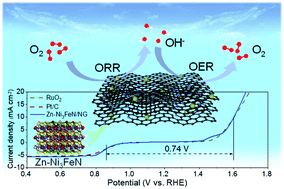Engineering the electronic states of Ni3FeN via zinc ion regulation for promoting oxygen electrocatalysis in rechargeable Zn–air batteries†
Abstract
Developing highly efficient bifunctional electrocatalysts for the oxygen reduction reaction (ORR) and oxygen evolution reaction (OER) is pivotal for large-scale commercial applications of Zn–air batteries. Herein, a Zn-doped Ni3FeN/nitrogen-doped graphene (Zn–Ni3FeN/NG) electrocatalyst was designed and synthesized via a facile and reliable method. Thanks to the electronic synergistic effect, the stress caused by lattice distortion from the Zn dopant embedded in Ni3FeN can alter the electronic environment of the peripheral regions and generate more catalytical active sites. The resultant Zn–Ni3FeN/NG exhibits a remarkable bifunctional electrochemical activity and stability, giving an overvoltage difference as low as 0.74 V. A Zn–air battery with Zn–Ni3FeN/NG as the air cathode shows an excellent cycle life and a high-power density of 158 mW cm−2, exceeding that of the apparatus based on commercial Pt/C and RuO2 (120 mW cm−2). Density functional theory (DFT) calculations reveal that the inserted Zn2+ ions can modulate the electronic structure of Ni3FeN and modify the adsorption/desorption features and lower the overall reaction barriers during the oxygen electrocatalytic reaction. This study offers a facile strategy for the design of highly efficient oxygen bifunctional electrocatalysts for energy-related technology.



 Please wait while we load your content...
Please wait while we load your content...